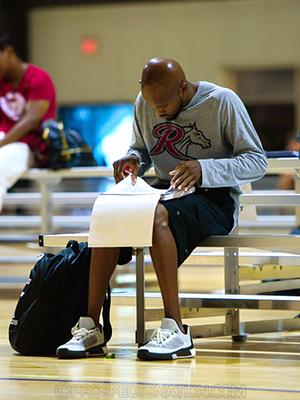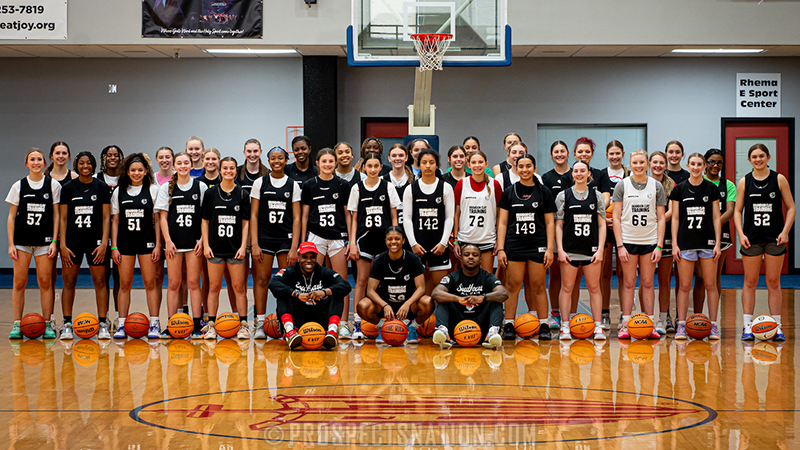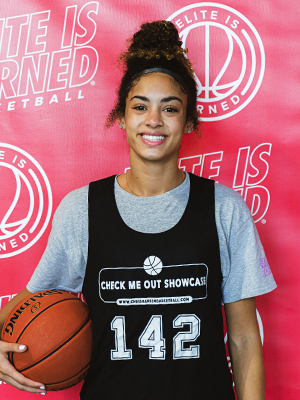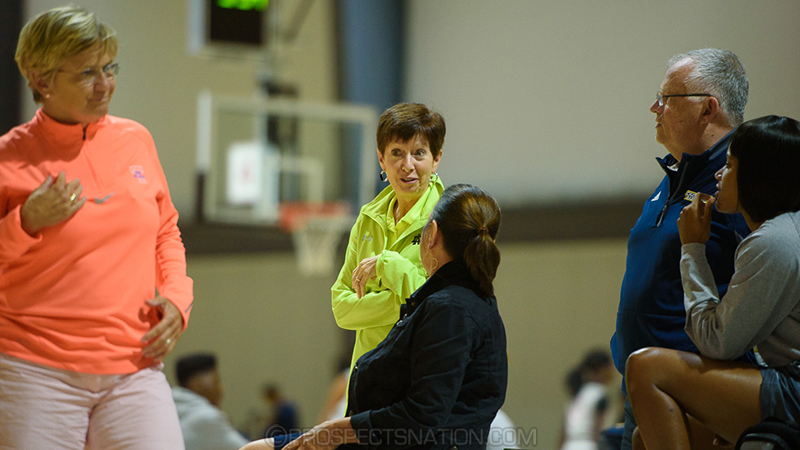
The fall evaluation weekend has been a bigger topic of conversation this year than any in the 12 years I’ve been covering recruiting in women’s basketball professionally. I’ve talked to countless club teams and college coaches, as I do every year, and here’s my attempt to break it down for those that don’t live in the space but are trying to make sense of it all.
One thing is clear: There is no one reason why the threatened boycott and heated discussion is happening.
The fall evaluation weekend is September 23-25, 2016, and allows college coaches to watch non-scholastic basketball during the scholastic year. Outside of this weekend and spring certified periods, college coaches cannot evaluate or recruit players in non-scholastic events (i.e. not in their high school season schedule) during the school year. It has been a regular part of the recruiting calendar, which is dictated by NCAA legislation, for as long as I’ve been around.
The Scholastic Model vs. Non-Scholastic
So why does non-scholastic basketball even exist? The short version is the average high school game doesn’t provide the number of players and quality of opponent to be effective as the sole evaluation platform.
 Case in point this past high school season, I went to see a player who ProspectsNation.com and most other outlets had nationally ranked. I heard the player was showing major progress in her game. I was flanked by two Division I college assistants at this game and the player everyone was there to watch was on the bench before halftime. While the player was clearly several cuts above the competition, the actual value in the evaluation was negligent. So in addition to providing more recruitable athletes to watch, non-scholastic basketball typically provides the competition to give those performances context. It’s hard to evaluate a host of uncontested layups at any event, be it club, showcase or high school action. Non-scholastic basketball answers the need for quantity and quality that scholastic basketball cannot.
Case in point this past high school season, I went to see a player who ProspectsNation.com and most other outlets had nationally ranked. I heard the player was showing major progress in her game. I was flanked by two Division I college assistants at this game and the player everyone was there to watch was on the bench before halftime. While the player was clearly several cuts above the competition, the actual value in the evaluation was negligent. So in addition to providing more recruitable athletes to watch, non-scholastic basketball typically provides the competition to give those performances context. It’s hard to evaluate a host of uncontested layups at any event, be it club, showcase or high school action. Non-scholastic basketball answers the need for quantity and quality that scholastic basketball cannot.
What exactly is the boycott about?
This probably is the most difficult part of all of this because there isn’t a consensus among the 352 Division I schools on the value of the weekend to begin with.
Packet Prices
There are numerous complaints about packet prices in women’s basketball, according to a CBS story. However, the average packet price of $227 for the 56 events listed on the NCAA certified events site in late August doesn’t seem to be enough evidence of the root issue. Many events on that list even offer day passes for much less than the packet price. The fall weekend is much more regional in nature and lacks the mega events, with a few exceptions, to demand the larger fees for coaches.
I discussed the fall weekend with a longtime assistant coach who has experience in both mid-major and power conference schools and his assertion was that the extra weekend is unnecessary. The July and April weekends are enough, that coach said.
 This may be true for some programs but it is not the universally accepted gospel. Some schools have the desire to go out but lack the funds to travel to events. Others stay home because the calendar allows official visits to take place the same weekend. Some feel the need to go out, evaluate, find players or make decisions on secondary options.
This may be true for some programs but it is not the universally accepted gospel. Some schools have the desire to go out but lack the funds to travel to events. Others stay home because the calendar allows official visits to take place the same weekend. Some feel the need to go out, evaluate, find players or make decisions on secondary options.
It’s Just Babysitting
Those who feel there is no evaluation value to the fall weekend have stated it serves more to babysitting kids that coaches have already decided are good enough for them. This happens in the spring and summer as well. Programs at every level have to balance their time and budgets with the need to see targeted recruits at their games. This is a more prevalent issue with programs that are more selective because their pool of players actually is smaller and progresses to the babysitting stage sooner. But, again, this happens in all evaluation periods.
Some schools skip their senior targets in the fall and use it as a chance to get out and see some young players they weren’t able watch as much in July because they were following their older targets.
If this were truly a unanimous issue, logic would say the coaches would handle the issue through the WBCA or NCAA legislative processes.
More Time With My Team
There also are some who feel this weekend on the road for coaches eliminates the time coaches can spend with their current team. It’s a valid concern; however the two hours per week allowed this time of year is pretty much uniformly taken during the week to give the players their weekends off. Given that those team hours are typically spent Monday/Wednesday or Tuesday/Thursday, according to the coaches interviewed, it’s hard to see this as the primary reason for skipping fall evaluation.
In addition to this weekend, which falls during the college preseason, coaches also can spend another 100-plus days on the road during the season, which limits the hours and types of practices they can have with their teams. Add up the travel and expense for 112 days of high school basketball evaluations and contacts, in addition to the days lost by the coaches doing this during their actual season, and it’s hard to understand how the fall weekend is any worse than the rest of the scholastic calendar.
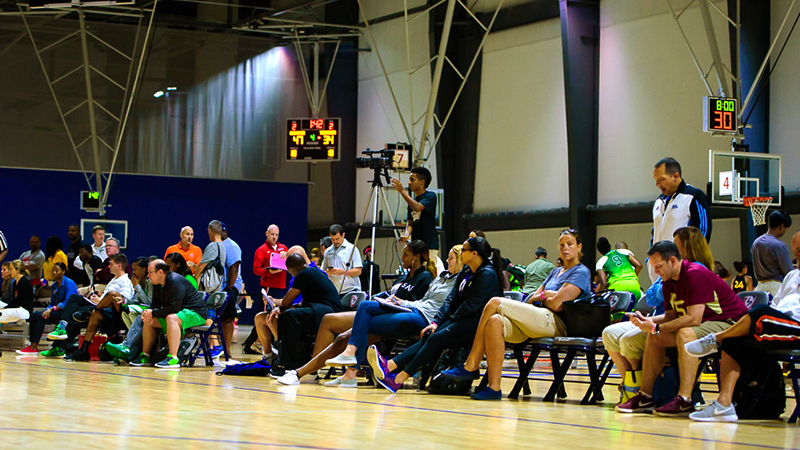 Coaches now can make unlimited in-home visits in the fall to juniors, in addition to seniors, according to legislation implemented last year. This is in addition to hosting their senior recruits for official campus visits. This happens both during the week and over the weekend in some instances. Several schools have told us these fall junior visits are crapshoots because most don’t know who they are signing in the senior class yet. One top 25 program visited eight different juniors last fall, prior to getting commitments from the senior class. Because of the success in recruiting seniors that eventually signed with the school, all eight of these prospective student athletes were dropped. All of this is just to say the fall is busy by choices the programs make with their time. Not all go full tilt on junior visits until the spring. Some do. Each school chooses how to use their 112 days, 7 yearly contacts and recruiting budget.
Coaches now can make unlimited in-home visits in the fall to juniors, in addition to seniors, according to legislation implemented last year. This is in addition to hosting their senior recruits for official campus visits. This happens both during the week and over the weekend in some instances. Several schools have told us these fall junior visits are crapshoots because most don’t know who they are signing in the senior class yet. One top 25 program visited eight different juniors last fall, prior to getting commitments from the senior class. Because of the success in recruiting seniors that eventually signed with the school, all eight of these prospective student athletes were dropped. All of this is just to say the fall is busy by choices the programs make with their time. Not all go full tilt on junior visits until the spring. Some do. Each school chooses how to use their 112 days, 7 yearly contacts and recruiting budget.
What’s in a boycott?
A boycott usually is a group of consumers attempting to provoke change from a group or business for a perceived wrong. In this case it’s confusing because the colleges not attending fall events, and calling their absence a boycott, are objecting to their own legislation. The voted recruiting calendar dictates when non-scholastic (club) teams and individual events can be played, which can hardly be the fault of the folks running events.
College coaches choosing not to send any or all of their staff out during the fall weekend, for many of the reasons discussed, is nothing new. If a prized recruit was set to come on campus it’s a smart business decision to keep most or all of the staff home or only go out for part of the evaluation period.
The damage in calling this a “boycott” against the weekend is the confusion and indecision it leaves for the club players, families and coaches who need to decide if entering a tournament and playing that weekend will result in a chance to be evaluated. The SEC coaches voted not to go out this fall, according to posts on social media, but should that mean other schools that want to go cannot?
"The situation is extremely unfortunate to a lot of clubs and thousands of prospective student athletes across the country," Kelly Sopak, director of the Cal Stars program, said. "Travel basketball is a labor of love for a lot of us and getting the kids the maximum amount of exposure is paramount. The rumors and lack of communication make it difficult for us to make an informed decision on what to or not to do this fall."
Several coaches have been pushed to stay home despite their desire to go out. Those coaches did not want to be named for fear of retribution from the coaches in their conference that want to stay home. One mid-major assistant said a power conference school contacted their head coach to tell them they can’t go out, either. This coach found the gambit laughable because the way his level of school can wrest a recruit from power conference schools is to outwork those programs.
Collateral Damage
Few think of the business side of this equation when it comes to changing the calendar in short time. Rewind the clock to the 2011-2012 cycle when the potential for a second spring weekend was put into legislation in the fall. Tournament organizers around the country ran out and signed contracts for gyms, many of which included non-refundable deposits.
 One of the biggest moves was to come from the Nike circuit, which behind Bill Larson and the North Tartan program, had designs on a second national level event that would include all of the Nike teams. Anyone who knows Larson knows he’s not a complainer, price gouger or pot stirrer when it comes to NCAA matters. But the truth is, when the NCAA suddenly removed the weekend two months before that new spring weekend was supposed to take place, perhaps nobody lost more than Larson did.
One of the biggest moves was to come from the Nike circuit, which behind Bill Larson and the North Tartan program, had designs on a second national level event that would include all of the Nike teams. Anyone who knows Larson knows he’s not a complainer, price gouger or pot stirrer when it comes to NCAA matters. But the truth is, when the NCAA suddenly removed the weekend two months before that new spring weekend was supposed to take place, perhaps nobody lost more than Larson did.
Gym rentals for an event of that magnitude are in excess of $20,000. Larson said he felt lucky to get off the hook for half of that when the event had to be cancelled. But the damage went beyond the loss of the gym deposit. It also wiped out the North Tartan Summer Jam event, a longtime, well-attended non-viewing event in June, which had been cancelled to make the May certified event happen.
Few if any college coaches will feel bad for an event operator in the current recruiting climate, but the point is not whether this fall weekend should be on the calendar, but the tactics for dealing with it don’t help players, especially uncommitted seniors, or schools who utilize the current calendar.
The message, even among the colleges participating, isn’t clear. Fixing that, coupled with active engagement in the legislative process, seems the appropriate route. Nobody is forcing any schools to go out. If it has no value to a school then there is no reason for that school to spend the money or hours away from their campus. It’s always been as simple as that. This year as in others, some schools will go out. Some schools will stay home.
What’s the point here?
After delving into all the reasons for which the fall weekend is presumed to be boycotted, there really isn’t a single reason behind the action. The fall evaluation period, like every other contact, evaluation and quiet period, carries different value for different programs and strategies. Forcing all teams to play according to others strategies only serves those who are benefiting from fewer opportunities to evaluate and recruit. A first year head coach, a team who saw its top targets pick other schools, or a program that is finished recruiting its 2017 class and wants to get ahead on the underclass kids, are being asked not to for reasons they don’t understand or agree with universally. It seems to reason that programs should use the existing calendar how they see fit, regardless of whether their competitors follow the same route.
 Chris Hansen is managing editor of ProspectsNation.com and serves on the McDonald’s All-American and Naismith Trophy selection committees. He was the co-founder and national director of scouting for ESPN HoopGurlz from 2005 until 2012 and is the director of the Check Me Out Showcase. He can be reached at chris@prospectsnation.com.
Chris Hansen is managing editor of ProspectsNation.com and serves on the McDonald’s All-American and Naismith Trophy selection committees. He was the co-founder and national director of scouting for ESPN HoopGurlz from 2005 until 2012 and is the director of the Check Me Out Showcase. He can be reached at chris@prospectsnation.com.

